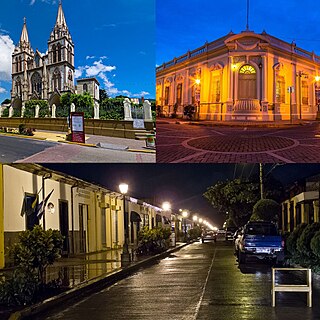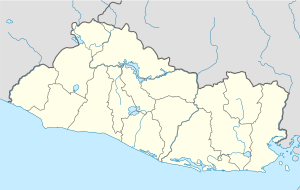
José Rafael Carrera y Turcios was the president of Guatemala from 1844 to 1848 and from 1851 until his death in 1865, after being appointed President for life in 1854. During his military career and presidency, new nations in Central America were facing numerous problems: William Walker's invasions, liberal attempts to overthrow the Catholic Church and aristocrats' power, the Civil War in the United States, Mayan uprising in the east, Belize boundary dispute with the United Kingdom, and the wars in Mexico under Benito Juárez. This led to a rise of caudillos, a term that refers to charismatic populist leaders among the indigenous people.

Tepatitlán de Morelos is a city and municipality founded in 1530, in the central Mexican state of Jalisco. It is located in the area known as Los Altos de Jalisco, about 70 km east of state capital Guadalajara. It is part of the macroregion of the Bajío. Its surrounding municipality of the same name had an area of 1,400 km2. Its most distinctive feature is the Baroque-style parish church in the centre of the city dedicated to Saint Francis of Assisi. Other notable sites include the kiosk that sits on the Plaza de Armas in downtown, the Temple of San Antonio, and the city hall. The latter is one of the most distinctive features in the city, built in neoclassic-baroque style.

Fusagasugá or Fusa is a city and municipality in the department of Cundinamarca, in central Colombia. It is located in the warm valley between the rivers Cuja and Panches, a central region of the Andes Mountains in South America. The municipality has a population of 138,498 and the urban centre a population of 114,722. The municipality itself covers an area of 194 km2 (75 sq mi).

Francisco Malespín Herrera was a Salvadoran military officer and politician, elected as the president of El Salvador in 1844. He served from 7 February 1844 to 15 February 1845, when he was deposed by his vice president Joaquín Eufrasio Guzmán after invading and overthrowing the liberal government in Nicaraguan. He also led El Salvador to a short unsuccessful war against Guatemala. After being deposed, Malespin returned to El Salvador with forces from Honduras, but he was captured and assassinated. Some of Malespin's closest allies were Francisco Ferrera in Honduras as well as Juan Lindo, both conservatives. He was supported by Honduras after his downfall.

Ayutuxtepeque is a municipality in the San Salvador department of El Salvador. It is one of the nine municipalities that make up the San Salvador Metropolitan Area (AMSS). The name of the municipality means "Armadillos Hill(or Mountain)"

San Juan Opico is a municipality in the La Libertad department of El Salvador.

La Palma is a municipality in the Chalatenango department of El Salvador. The municipality, located in a mountainous area of the country, covers an area of 135.60 km2 and as of 2006 had an approximate population of 24,000.

Alejandría is a town and municipality in the Antioquia Department, Colombia. It is part of the sub-region of Eastern Antioquia and is bordered to the north by the municipalities of Concepción, Santo Domingo and San Roque, on the east by the municipality of San Rafael, on the south by the municipalities of San Rafael and Guatapé, and on the west by the municipalities of El Penol and Concepción. Its capital is 90 kilometers from the city of Medellin, the capital of Antioquia department. The municipality has an area of 149 km2.

Santa Tecla is a city in the La Libertad department of El Salvador. It is the capital of the department of La Libertad.
Agua Caliente is a municipality in the Chalatenango department of El Salvador.

Almoloya de Juárez is a town in the State of Mexico and the seat of the municipality of Almoloya de Juárez. The name Almoloya comes from the Nahuatl, that is properly Almoloyan, composed of: atl, "water"; molo "impersonal voice of moloni, to flow the source" and yan, "place"; that it means "place where flows the water source".

Ixtapaluca is a city and a municipality in the eastern part of the State of Mexico in Mexico. It lies between Mexico City and the western border of the state of Puebla. The name Ixtapaluca means "Where the salt gets wet".

San Juan Bautista Tuxtepec, or simply referred to as Tuxtepec, is the head of the municipality by the same name and is the second most populous city of the Mexican state of Oaxaca. It is part of the Tuxtepec District of the Papaloapan Region. As of the 2020 census, the city is home to a population of 103,609 and 159,452 in the municipality, though census data are often under reported for various reasons.

Nueva Esparta is a municipality in the northeasternmost zone of El Salvador, inside La Unión Department. The municipality is politically divided into the central Pueblo Nueva Esparta, six outlying canton communities and 31 caserios.

Santiago Papasquiaro is a municipality in the Mexican state of Durango. The municipal seat lies at Santiago Papasquiaro. The municipality covers an area of 7,238.4 km2. Santiago Papasquiaro municipality is at an average height of 1,730 m (5,675 ft) over the sea level. The municipality lies east of Sierra Madre Occidental Mountain Range. It neighbors with the municipalities of Canelas and Tepehuanes to the north, San Dimas and Otáez to the south, Nuevo Ideal to the east, Tamazula to the west and El Oro to the northeast.

Mariano Rivera Paz was Head of State of Guatemala and its first president.

Mariano de Aycinena y Piñol was wealthy and influential Guatemalan merchant family and an important conservative politician. A younger son of the first marquis of Aycinena, peninsular-born Juan Fermín de Aycinena (1729-1796), Mariano was a leader of Guatemalan independence from Spain. He served governor of the State of Guatemala in the Central American Federation from 1 March 1827 to 12 April 1829 and patriarch of the Aycinena family. The family had the commercial monopoly in Central American during the Spanish colonial era later year thanks to the Consulado de Comercio. He was one of the signatories of Central American independence and lobbied heavily for the annexation of Central America to the Mexican Empire of Agustín de Iturbide. This arrangement would keep the family's economic position and privileges following independence. After being expelled along with the Aycinena family in 1829 after being defeated by Francisco Morazán, went into exile in the United States and then to Mexico. He came back to Guatemala after the conservatives had allied with general Rafael Carrera; but then he retired from public life and hand the Aycinena family leadership to Juan José de Aycinena y Piñol.


















